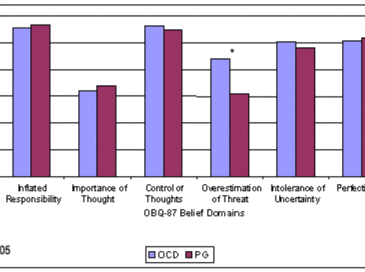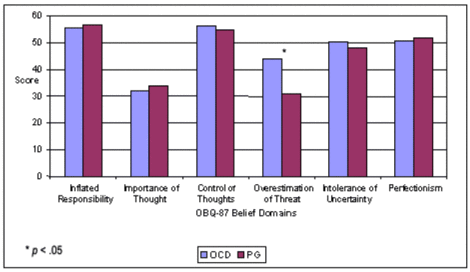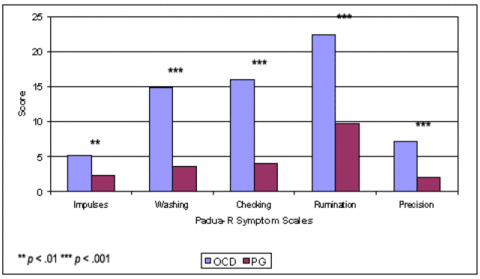According to DSM-IV classification (American Psychiatric Association, 1994), pathological gambling (PG) falls into the category of impulse control disorders and obsessive-compulsive disorder (OCD) falls into the category of anxiety disorders. PG is characterized by the inability to resist the urge to gamble; OCD involves harm-avoidance behaviors. However, another classification theory has emerged that groups pathological gambling within a spectrum of obsessive-compulsive disorders, identified by an inability to delay or prevent oneself from engaging in repetitive behaviors. Obsessive-compulsive spectrum disorder (OCSD) theory (Hollander, Kwon, Stein, Broatch, Rowland, & Himelein, 1996) groups these disorders on a continuum from compulsive disorders at one end (i.e., OCD and other disorders in which a person overestimates possible harm) to impulsive disorders at the other (i.e., PG and other disorders in which a person underestimates or disregards possible harm).
The placement of PG within this spectrum has been debated extensively (see WAGERs 4(19), 5(46), 7(23), and 7(24)), but only a few empirical studies have addressed the topic (e.g., Blaszczynski, 1999). To determine whether pathological gambling fits within this OCSD spectrum, a recent study by Anholt, Emmelkamp, Cath, van Oppen, Nelissen, and Smit (2004) examined whether pathological gamblers share beliefs and symptoms similar to those of OCD patients.
Participants were drawn from four groups: (1) obsessive compulsive patients (n = 66), (2) pathological gambling patients (n = 20), (3) patients with panic disorder and/or agoraphobia (n = 20), and (4) controls who had not sought mental health treatment. The undiagnosed control group was selected randomly from the Amsterdam phone book; other participants were recruited from an outpatient anxiety clinic or from an outpatient addiction center, both in Amsterdam. The researchers excluded from the study patients receiving SSRI or psychotherapeutic treatment and patients with more than one of the disorders being evaluated in this study. The investigators administered participants the Padua-R1 (Sanavio, 1998), an inventory of OCD symptoms (i.e., impulses, washing, checking, rumination, and precision), as well as the Obsessive-compulsive Beliefs Questionnaire-872 (OBQ-87,Obsessive Compulsive Cognitions Working Group (OCCWG), 1997), a survey of six belief domains characteristic of OCD patients – inflated responsibility, over-importance of thoughts, control of thoughts, overestimation of threat, intolerance of uncertainty, and perfectionism.
Anholdt et al. (2004) conducted analyses of variance (ANOVAs) with contrasts comparing each group’s questionnaire responses to those of the OCD group3. They found that although OCD patients scored significantly higher on the OBQ-87 than other groups overall, F(3,127) = 9.4, p < .001, there was not a significant difference in scores between OCD patients and pathological gamblers. The results from the belief domain subscales of the OBQ-87 indicated that OCD patients scored significantly higher than pathological gamblers on only one of the six domains: ‘overestimation of threat,’ (p < .05); on all other OBQ-87 comparisons, the two groups scored similarly. On the Padua-R measure of OCD symptomatology, OCD patients scored higher than all other groups, F(3,127) = 35.77, p < .001. When compared specifically to pathological gamblers, OCD patients scored significantly higher on all Padua-R subscales (p < 0.01 for impulses and p < 0.001 for the rest of the subscales).
Figure 1: Mean scores on OBQ-87 Belief Domains for OCD and PG groups (adapted from Anholt et al., 2004)
Figure 2: Mean scores on Padua-R symptom scales for OCD and PG groups (adapted from Anholt et al., 2004)
Scores from the OBQ-87 questionnaire, mainly that the OCD group did not score significantly higher than the pathological gambling group on most domains, seem to support OCSD theory. Further, the domain on which OCD patients did score higher than pathological gamblers, “overestimation of threat,” supports the anchoring of these two disorders at the two ends of the OCSD spectrum (i.e., harm avoidance / compulsion and sensation seeking / impulsivity, respectively). However, the scores from the Padua-R measure seem to contradict the relationship described above: pathological gamblers scored significantly lower than OCD patients and received scores similar to the undiagnosed control group for all symptom subscales; OCD patients scored more similarly to the panic disorder group than to pathological gamblers on most subscales.
Though the inclusion of PG in the OCSD spectrum is supported by results of the OBQ-87, which examines beliefs and cognitions indicative of OCD, it is not supported by the Padua-R, which examines symptoms shared of OCD. It is important to keep in mind, however, that the results from the OBQ-87 were null findings – the absence of significant differences. The absence of significant findings could be a result of one of the limitations to this study (e.g., the small sample-size could limit the power to detect differences; the inclusion of only diagnosed patients in treatment program could limit the generalizability to non-treatment seeking groups). The absence of findings suggests that it is important to continue to investigate whether PG belongs on a continuum incorporating both compulsions and impulses. Further research is necessary, however, to determine the implications of the high level of shared beliefs between OCD and PG and low level of shared symptoms, as shown by the OBQ-87 and Padua-R results. Whether these findings support or contradict spectrum theory remains to be determined.
Comments on this article can be addressed to Siri Odegaard.
Notes
1 The Padua-R measures OCD symptoms using five subscales: impulses, washing, checking, rumination, and precision (41 items in revised version).
2 The OBQ-87 measures belief domains characteristic of OCD patients using six subscales: inflated responsibility, over-importance of thoughts, control of thoughts, overestimation of threat, intolerance of uncertainty, and perfectionism (87 items).
3 The investigators conducted multivariate analyses of variance at well, but report detailed results only from the univariate comparisons presented in this review.
References
American Psychiatric Association. (1994). DSM-IV: Diagnostic and statistical manual of mental disorders (Fourth ed., pp. 886). Washington, D.C.: American Psychiatric Association.
Anholt, G. E., Emmelkamp, P. M. G., Cath, D. C., van Oppen, P., Nelissen, H., & Smit, J. H. (2004). Do patients with OCD and pathological gambling have similar dysfunctional cognitions?, Behaviour Research and Therapy (Vol. 42, pp. 529537).
Blaszczynski, A. (1999). Pathological gambling and obsessive-compulsive spectrum disorders. In Psychological Reports (Vol. 84, pp. 107-113).
Hollander, E., Kwon, J. H., Stein, D. J., Broatch, J., Rowland, C. T., & Himelein, C. A. (1996). Obsessive compulsive spectrum disorders: Overview and quality of life issues, Journal of Clinical Psychiatry (Vol. 57, pp. 3-6).
Obsessive Compulsive Cognitions Working Group (OCCWG). (1997). Cognitive assessment of obsessive-compulsive disorder, Behaviour Research & Therapy (Vol. 35, pp. 667681).
Sanavio, E. (1998). Obsessions and compulsions: The Padua Inventory, Behaviour Research & Therapy (Vol. 26, pp. 167177).






